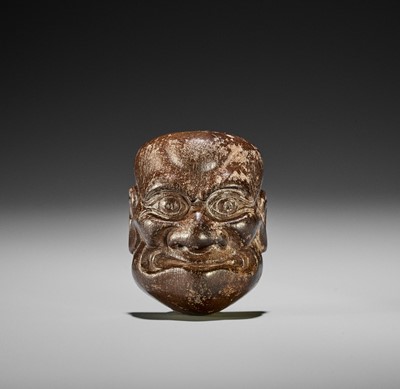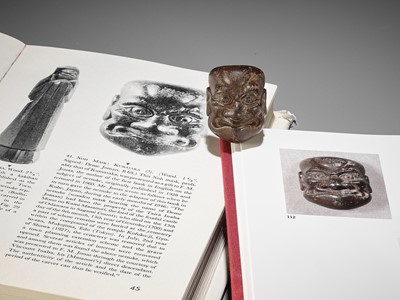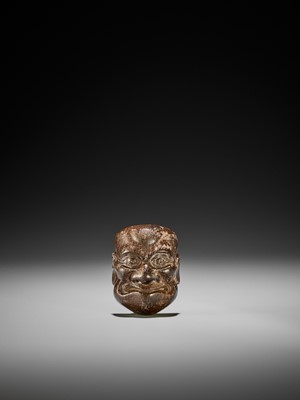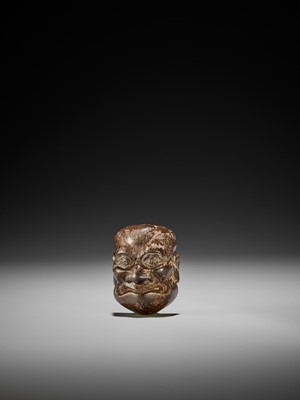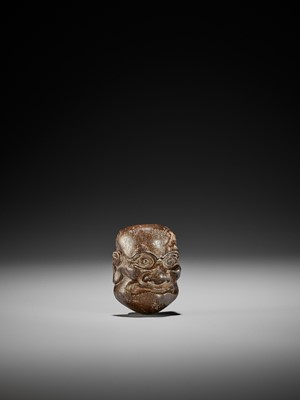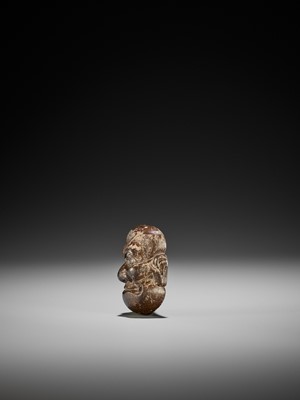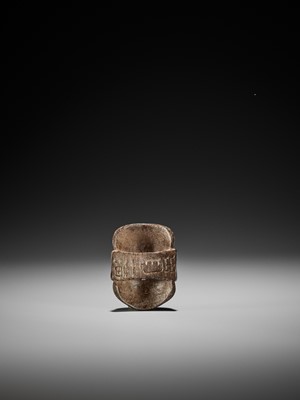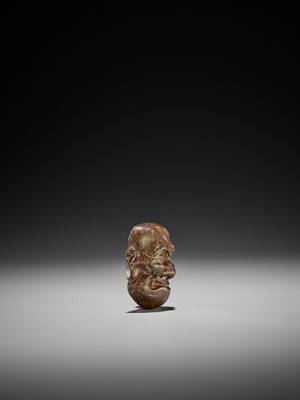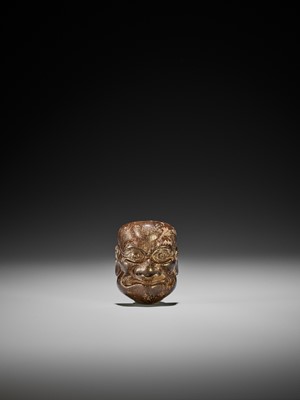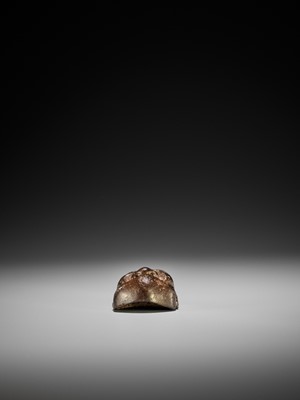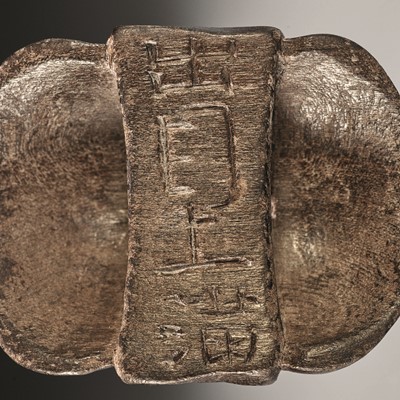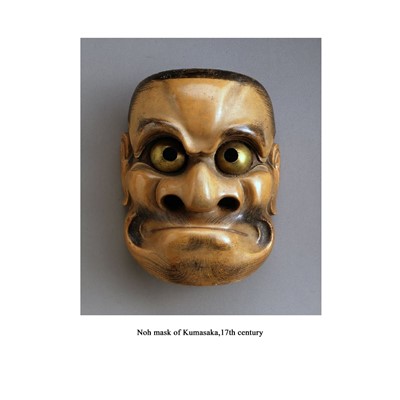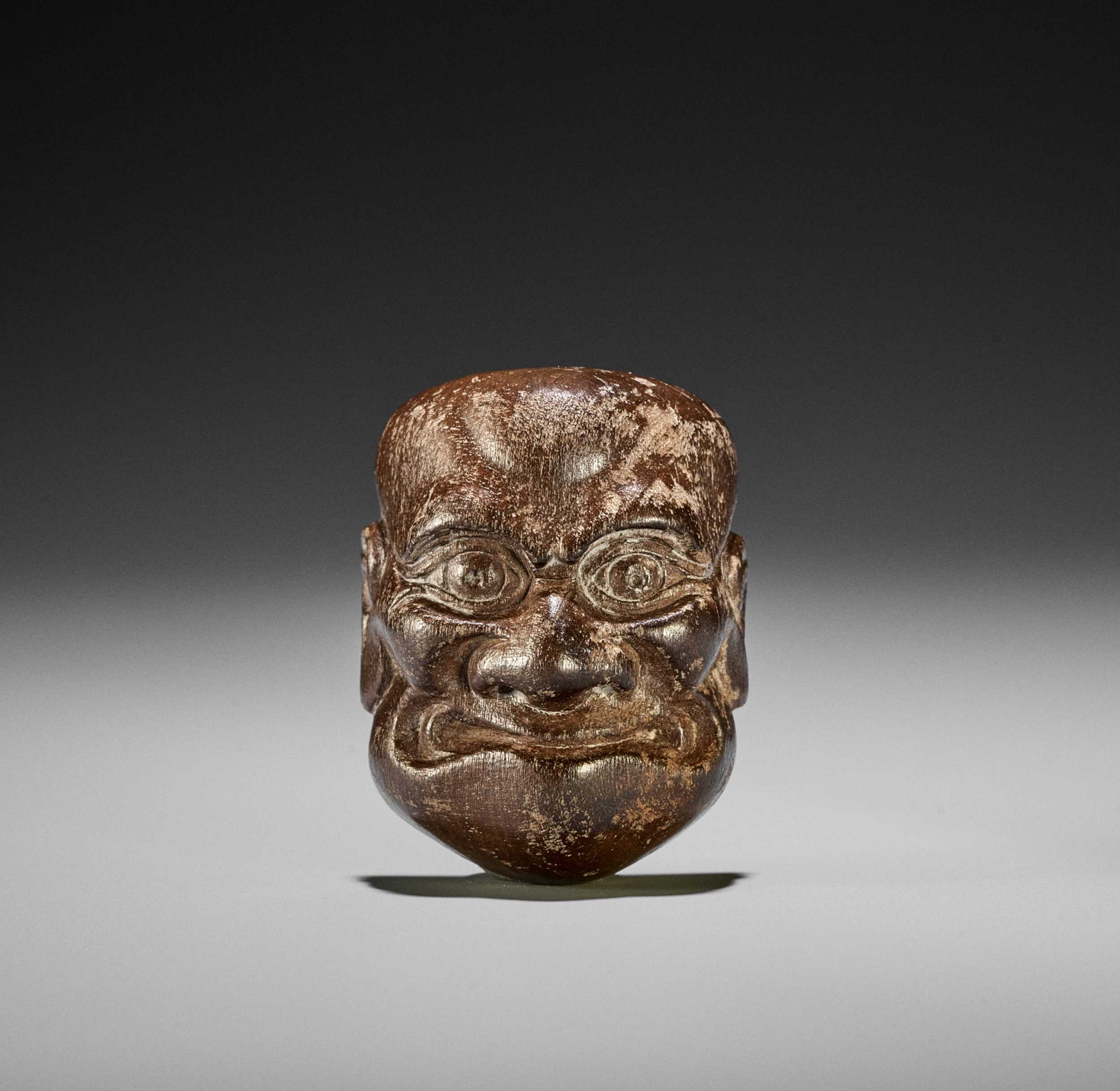29th Oct, 2021 13:00
Fine Netsuke & Sagemono
253
DEME JOMAN: A HIGHLY IMPORTANT WOOD NOH MASK NETSUKE OF KUMASAKA, EXCAVATED FROM THE TOMB OF LORD TAIRA INABA MONO NO KAMI MASANORI, C. 1700
Sold for €4,045
including Buyer's Premium
By Deme Joman, signed Deme Joman 出目上滿
Japan, Edo (Tokyo), c. 1700, Edo period (1615-1868)
Published:
Bushell, Raymond (1961) The Netsuke Handbook by Ueda Reikichi, p. 45, fig. 41.
Bushell, Raymond (1985) Netsuke Masks, no. 112.
Expressively carved from wood depicting Kumasaka, pierced himotoshi underneath the thick bar in the back which shows the boldly incised signature DEME JOMAN.
While being a fine and typical example of a Noh mask netsuke by the famous Deme family, this piece particularly stands out due to its interesting and highly important history. This mask netsuke was presented as a gift to F. M. Jonas, the author of the first book in English on the subject of netsuke, originally published in 1928. As Ueda Reikichi states in her book Netsuke no Kenkyu, Mr. Jonas wrote as follows when he in turn gave the netsuke to the adaptor of this book (Raymond Bushell) in Kobe, Japan, during the early months of 1946: “The netsuke (wooden mask bearing the name of Deme Joman) had been the property of the Taira Inaba Mono no Kami Masanori, the lord of the feudal castle of Odawara in Sagami County, who died on the 13th day of the 9th month, 13th year of Genroku (1700) and a part of whose remains were buried at the cemetery within the compound of the temple Kofuku-ji, Gyoto-san, Mukojima, Edo (Tokyo). In July, 2nd year of Showa (1927), the cemetery was removed due to a town planning extension scheme and the grave opened. Several articles of interest were recovered and among them was found the above netsuke, which was presented to F. M. Jonas through the courtesy of Viscount Inaba, his [Masanori’s] direct descendant. The authenticity of the article and the date of the period of the carver can thus be verified.”
This effectively makes the present piece the earliest recorded netsuke and the only one discovered inside a grave, perhaps hinting at a common practice during the Edo period. Another interesting aspect of this piece is the peculiar patina which has resulted from it being submerged for such a long time.
The Deme family was a famous family of mask carvers from the 10th century onwards. Ueda Reikichi states that Deme Eiman (died in 1705) was the originator of the mask netsuke. Deme Joman was a younger brother of Deme Juman, who was the son of Deme Eiman.
The Kumasaka mask with humorous-looking round eyeballs is exclusively used for the Noh plays Kumasaka and Eboshiori. Both appear on the stage as a robber named Kumasaka Chohan, who is subdued by Ushiwakamaru (a famous warrior, later Minamoto no Yoshitsune).
HEIGHT 4.3 cm
Condition: Good undamaged condition, some rubbing and wear.
Provenance: Ex-collections F. M. Jonas and Raymond Bushell. Then European private collection P. Jacquesson acquired at Sotheby’s, 21 March 2001, New York.
By Deme Joman, signed Deme Joman 出目上滿
Japan, Edo (Tokyo), c. 1700, Edo period (1615-1868)
Published:
Bushell, Raymond (1961) The Netsuke Handbook by Ueda Reikichi, p. 45, fig. 41.
Bushell, Raymond (1985) Netsuke Masks, no. 112.
Expressively carved from wood depicting Kumasaka, pierced himotoshi underneath the thick bar in the back which shows the boldly incised signature DEME JOMAN.
While being a fine and typical example of a Noh mask netsuke by the famous Deme family, this piece particularly stands out due to its interesting and highly important history. This mask netsuke was presented as a gift to F. M. Jonas, the author of the first book in English on the subject of netsuke, originally published in 1928. As Ueda Reikichi states in her book Netsuke no Kenkyu, Mr. Jonas wrote as follows when he in turn gave the netsuke to the adaptor of this book (Raymond Bushell) in Kobe, Japan, during the early months of 1946: “The netsuke (wooden mask bearing the name of Deme Joman) had been the property of the Taira Inaba Mono no Kami Masanori, the lord of the feudal castle of Odawara in Sagami County, who died on the 13th day of the 9th month, 13th year of Genroku (1700) and a part of whose remains were buried at the cemetery within the compound of the temple Kofuku-ji, Gyoto-san, Mukojima, Edo (Tokyo). In July, 2nd year of Showa (1927), the cemetery was removed due to a town planning extension scheme and the grave opened. Several articles of interest were recovered and among them was found the above netsuke, which was presented to F. M. Jonas through the courtesy of Viscount Inaba, his [Masanori’s] direct descendant. The authenticity of the article and the date of the period of the carver can thus be verified.”
This effectively makes the present piece the earliest recorded netsuke and the only one discovered inside a grave, perhaps hinting at a common practice during the Edo period. Another interesting aspect of this piece is the peculiar patina which has resulted from it being submerged for such a long time.
The Deme family was a famous family of mask carvers from the 10th century onwards. Ueda Reikichi states that Deme Eiman (died in 1705) was the originator of the mask netsuke. Deme Joman was a younger brother of Deme Juman, who was the son of Deme Eiman.
The Kumasaka mask with humorous-looking round eyeballs is exclusively used for the Noh plays Kumasaka and Eboshiori. Both appear on the stage as a robber named Kumasaka Chohan, who is subdued by Ushiwakamaru (a famous warrior, later Minamoto no Yoshitsune).
HEIGHT 4.3 cm
Condition: Good undamaged condition, some rubbing and wear.
Provenance: Ex-collections F. M. Jonas and Raymond Bushell. Then European private collection P. Jacquesson acquired at Sotheby’s, 21 March 2001, New York.
Zacke Live Online Bidding
Our online bidding platform makes it easier than ever to bid in our auctions! When you bid through our website, you can take advantage of our premium buyer's terms without incurring any additional online bidding surcharges.
To bid live online, you'll need to create an online account. Once your account is created and your identity is verified, you can register to bid in an auction up to 12 hours before the auction begins.
Intended Spend and Bid Limits
When you register to bid in an online auction, you will need to share your intended maximum spending budget for the auction. We will then review your intended spend and set a bid limit for you. Once you have pre-registered for a live online auction, you can see your intended spend and bid limit by going to 'Account Settings' and clicking on 'Live Bidding Registrations'.
Your bid limit will be the maximum amount you can bid during the auction. Your bid limit is for the hammer price and is not affected by the buyer’s premium and VAT. For example, if you have a bid limit of €1,000 and place two winning bids for €300 and €200, then you will only be able to bid €500 for the rest of the auction. If you try to place a bid that is higher than €500, you will not be able to do so.
Online Absentee and Telephone Bids
You can now leave absentee and telephone bids on our website!
Absentee Bidding
Once you've created an account and your identity is verified, you can leave your absentee bid directly on the lot page. We will contact you when your bids have been confirmed.
Telephone Bidding
Once you've created an account and your identity is verified, you can leave telephone bids online. We will contact you when your bids have been confirmed.
Classic Absentee and Telephone Bidding Form
You can still submit absentee and telephone bids by email or fax if you prefer. Simply fill out the Absentee Bidding/Telephone bidding form and return it to us by email at office@zacke.at or by fax at +43 (1) 532 04 52 20. You can download the PDF from our Upcoming Auctions page.
How-To Guides
How to Create Your Personal Zacke Account
How to Register to Bid on Zacke Live
How to Leave Absentee Bids Online
How to Leave Telephone Bids Online
中文版本的操作指南
创建新账号
注册Zacke Live在线直播竞拍(免平台费)
缺席投标和电话投标
Third-Party Bidding
We partner with best-in-class third-party partners to make it easy for you to bid online in the channel of your choice. Please note that if you bid with one of our third-party online partners, then there will be a live bidding surcharge on top of your final purchase price. You can find all of our fees here. Here's a full list of our third-party partners:
- 51 Bid Live
- EpaiLive
- ArtFoxLive
- Invaluable
- LiveAuctioneers
- the-saleroom
- lot-tissimo
- Drouot
Please note that we place different auctions on different platforms. For example, in general, we only place Chinese art auctions on 51 Bid Live.
Bidding in Person
You must register to bid in person and will be assigned a paddle at the auction. Please contact us at office@zacke.at or +43 (1) 532 04 52 for the latest local health and safety guidelines.

